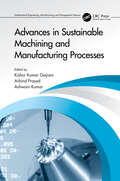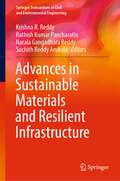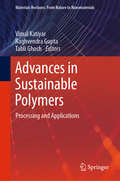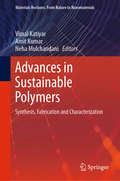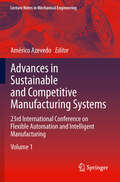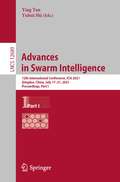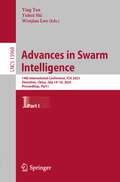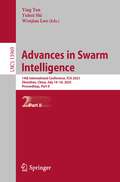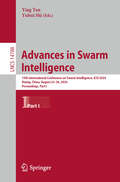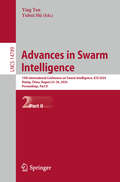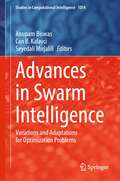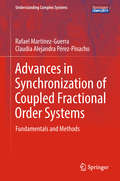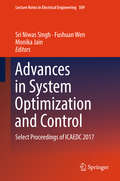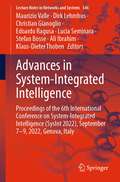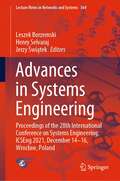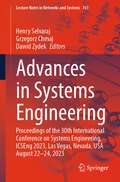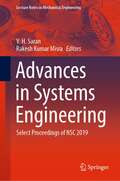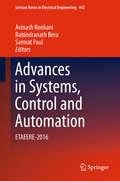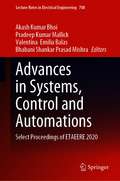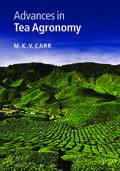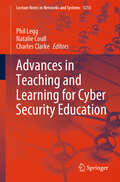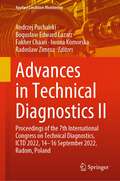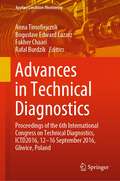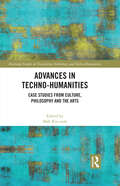- Table View
- List View
Advances in Sustainable Machining and Manufacturing Processes (ISSN)
by Ashwani Kumar Kishor Kumar Gajrani Arbind PrasadThis text provides an in-depth overview of sustainability in machining processes, challenges during machining of difficult-to-cut materials and different ways of green machining in achieving sustainability.It discusses important topics including green and sustainable machining, dry machining, textured cutting coated tools for machining, solid lubricants-based machining, gas-cooled machining, cryogenic cooling for intelligent machining, artificial neural network for machining, big data based machining, and hybrid intelligent machining. This book- Covers advances in sustainable machining such as gas-cooled machining, near dry machining, and minimum quantity lubrication. Explores use of big data, machine learning and artificial intelligence for machining processes. Provides case studies and experimental design as well as results with analysis focusing on achieving sustainability. Discusses artificial intelligence and machine learning based machining processes. Cover the latest applications of sustainable manufacturing for a better understanding of the concepts. The text is primarily written for senior undergraduate, graduate students, and researchers in the fields of mechanical, manufacturing, industrial, production engineering and materials science.
Advances in Sustainable Materials and Resilient Infrastructure (Springer Transactions in Civil and Environmental Engineering)
by Krishna R. Reddy Rathish Kumar Pancharathi Narala Gangadhara Reddy Suchith Reddy ArukalaThe edited book comprises invited book chapter contributions from global experts in the field of sustainable materials and resilient infrastructure. The book covers the most critical and emerging topics for creating sustainable solutions for the construction industry, promoting the technologies and monitoring methods for resilient infrastructure. It focuses on sustainable solutions and offers techniques and methodologies to deliver high-quality end solutions in civil engineering. In addition, the content provides knowledge-based information for the readers to assess, monitor, measure, and practice sustainability for resilient infrastructure. The contents of the volume are a blend of academic research work and industrial case studies. It covers the use of sustainable materials like Lime-Pozzolona Binders, biopolymers, lignosulphonate, lightweight aggregates made from fly ash, calcinated clay, paper ash, and limestone as amendments/ameliorators for soil remediation, development of neo-construction materials and composites for civil engineering applications. Design of innovative pavements using alkali activation and pervious concrete for sustainable infrastructure is also discussed. The chapters also highlight the role of civil engineers in achieving UN Sustainable Development Goals, promoting climate change design for urban landscapes, and modelling building energy demand. This book is framed to address the principles and practice from the corners of geoenvironment, sustainable construction materials, low carbon materials, energy efficiency, and waste management. It is a valuable reference for faculty, researchers, field experts, scientists, and practicing engineers.
Advances in Sustainable Polymers: Processing and Applications (Materials Horizons: From Nature to Nanomaterials)
by Vimal Katiyar Raghvendra Gupta Tabli GhoshThis book provides a systematic overview of the processing and applications of sustainable polymers. The volume covers recent advances in biomedical, food packaging, fuel cell, membrane, and other emerging applications. The book begins by addressing different sections of biomedical application including use of carbohydrate-based therapeutics, nanohybrids, nanohydrogels, bioresorbable polymers and their composites, polymer-grafted nanobiomaterials for biomedical devices and implants, nanofibres, and others. The second part of this book discusses various processing and packaging materials for food packaging applications. The last section discusses other emerging applications, including using microbial fuel cells for waste water treatment, microfluidic fuel cells for low power applications, among others. This volume will be relevant to researchers working to improve the properties of bio-based materials for their advanced application and wide commercialization.
Advances in Sustainable Polymers: Synthesis, Fabrication and Characterization (Materials Horizons: From Nature to Nanomaterials)
by Amit Kumar Vimal Katiyar Neha MulchandaniThis book discusses synthesis and characterization of sustainable polymers. The book covers opportunities and challenges of using sustainable polymers to replace existing petroleum based feedstock. This volume provides insights into the chemistry of polymerization, and discusses tailoring the properties of the polymers at the source in order fit requirements of specific applications. The book also covers processing of these polymers and their critical assessment. The book will be of use to chemists and engineers in the industry and academia working on sustainable polymers and their commercialization to replace dependence on petroleum-based polymers.
Advances in Sustainable and Competitive Manufacturing Systems: 23rd International Conference on Flexible Automation & Intelligent Manufacturing (Lecture Notes in Mechanical Engineering)
by Américo AzevedoThe proceedings includes the set of revised papers from the 23rd International Conference on Flexible Automation and Intelligent Manufacturing (FAIM 2013). This conference aims to provide an international forum for the exchange of leading edge scientific knowledge and industrial experience regarding the development and integration of the various aspects of Flexible Automation and Intelligent Manufacturing Systems covering the complete life-cycle of a company's Products and Processes. Contents will include topics such as: Product, Process and Factory Integrated Design, Manufacturing Technology and Intelligent Systems, Manufacturing Operations Management and Optimization and Manufacturing Networks and MicroFactories.
Advances in Swarm Intelligence: 12th International Conference, ICSI 2021, Qingdao, China, July 17–21, 2021, Proceedings, Part I (Lecture Notes in Computer Science #12689)
by Ying Tan Yuhui Shihis two-volume set LNCS 12689-12690 constitutes the refereed proceedings of the 12th International Conference on Advances in Swarm Intelligence, ICSI 2021, held in Qingdao, China, in July 2021. The 104 full papers presented in this volume were carefully reviewed and selected from 177 submissions. They cover topics such as: Swarm Intelligence and Nature-Inspired Computing; Swarm-based Computing Algorithms for Optimization; Particle Swarm Optimization; Ant Colony Optimization; Differential Evolution; Genetic Algorithm and Evolutionary Computation; Fireworks Algorithms; Brain Storm Optimization Algorithm; Bacterial Foraging Optimization Algorithm; DNA Computing Methods; Multi-Objective Optimization; Swarm Robotics and Multi-Agent System; UAV Cooperation and Control; Machine Learning; Data Mining; and Other Applications.
Advances in Swarm Intelligence: 14th International Conference, ICSI 2023, Shenzhen, China, July 14–18, 2023, Proceedings, Part I (Lecture Notes in Computer Science #13968)
by Ying Tan Yuhui Shi Wenjian LuoThis two-volume set LNCS 13968 and 13969 constitutes the proceedings of the 14th International Conference on Advances in Swarm Intelligence, ICSI 2023, which took place in Shenzhen, China, China, in July 2023. The theme of this year’s conference was “Serving Life with Swarm Intelligence”.The 81 full papers presented were carefully reviewed and selected from 170 submissions. The papers are organized into 12 cohesive sections covering major topics of swarm intelligence research and its development and applications. The papers of the first part cover topics such as: Swarm Intelligence Computing; Swarm Intelligence Optimization Algorithms; Particle Swarm Optimization Algorithms; Genetic Algorithms; Optimization Computing Algorithms; Neural Network Search & Large-Scale Optimization; Multi-objective Optimization.
Advances in Swarm Intelligence: 14th International Conference, ICSI 2023, Shenzhen, China, July 14–18, 2023, Proceedings, Part II (Lecture Notes in Computer Science #13969)
by Ying Tan Yuhui Shi Wenjian LuoThis two-volume set LNCS 13968 and 13969 constitutes the proceedings of the 14th International Conference on Advances in Swarm Intelligence, ICSI 2023, which took place in Shenzhen, China, China, in July 2023. The theme of this year’s conference was “Serving Life with Swarm Intelligence”. The 81 full papers presented were carefully reviewed and selected from 170 submissions. The papers are organized into 12 cohesive sections covering major topics of swarm intelligence research and its development and applications. The papers of the second part cover topics such as: Swarm Robotics and UAV; Machine Learning; Data Mining; Routing and Scheduling Problems; Stock Prediction and Portfolio Optimization; ICSI-Optimization Competition.
Advances in Swarm Intelligence: 15th International Conference on Swarm Intelligence, ICSI 2024, Xining, China, August 23–26, 2024, Proceedings, Part I (Lecture Notes in Computer Science #14788)
by Ying Tan Yuhui ShiThis two-volume set LNCS 14788 and 14789 constitutes the refereed post-conference proceedings of the 15th International Conference on Advances in Swarm Intelligence, ICSI 2024, held in Xining, China, during August 23–26, 2024. The 74 revised full papers presented in these proceedings were carefully reviewed and selected from 156 submissions. The papers are organized in the following topical sections: Part I - Particle swarm optimization; Swarm intelligence computing; Differential evolution; Evolutionary algorithms; Multi-agent reinforcement learning & Multi-objective optimization. Part II - Route planning problem; Machine learning; Detection and prediction; Classification; Edge computing; Modeling and optimization & Analysis of review.
Advances in Swarm Intelligence: 15th International Conference on Swarm Intelligence, ICSI 2024, Xining, China, August 23–26, 2024, Proceedings, Part II (Lecture Notes in Computer Science #14789)
by Ying Tan Yuhui ShiThis two-volume set LNCS 14788 and 14789 constitutes the refereed post-conference proceedings of the 15th International Conference on Advances in Swarm Intelligence, ICSI 2024, held in Xining, China, during August 23–26, 2024. The 74 revised full papers presented in these proceedings were carefully reviewed and selected from 156 submissions. The papers are organized in the following topical sections: Part I - Particle swarm optimization; Swarm intelligence computing; Differential evolution; Evolutionary algorithms; Multi-agent reinforcement learning & Multi-objective optimization. Part II - Route planning problem; Machine learning; Detection and prediction; Classification; Edge computing; Modeling and optimization & Analysis of review.
Advances in Swarm Intelligence: Variations and Adaptations for Optimization Problems (Studies in Computational Intelligence #1054)
by Seyedali Mirjalili Anupam Biswas Can B. KalayciSwarm Intelligence (SI) has grown significantly, both from the perspective of algorithmic development and applications covering almost all disciplines science and technology. This book emphasizes the studies of existing SI techniques, their variants and applications. The book also contains reviews of new developments in SI techniques and hybridizations. Algorithm specific studies covering basic introduction and analysis of key components of these algorithms, such as convergence, balance of solution accuracy, computational costs, tuning and control of parameters. Application specific studies incorporating the ways of designing objective functions, solution representation and constraint handling. The book also includes studies on application domain specific adaptations in the SI techniques. The book will be beneficial for academicians and researchers from various disciplines of engineering and science working in applications of SI and other optimization problems.
Advances in Synchronization of Coupled Fractional Order Systems: Fundamentals and Methods (Understanding Complex Systems)
by Rafael Martínez-Guerra Claudia Alejandra Pérez-PinachoAfter a short introduction to the fundamentals, this book provides a detailed account of major advances in applying fractional calculus to dynamical systems. Fractional order dynamical systems currently continue to gain further importance in many areas of science and engineering. As with many other approaches to mathematical modeling, the first issue to be addressed is the need to couple a definition of the fractional differentiation or integration operator with the types of dynamical systems that are analyzed. As such, for the fundamentals the focus is on basic aspects of fractional calculus, in particular stability analysis, which is required to tackle synchronization in coupled fractional order systems, to understand the essence of estimators for related integer order systems, and to keep track of the interplay between synchronization and parameter observation. This serves as the common basis for the more advanced topics and applications presented in the subsequent chapters, which include an introduction to the 'Immersion and Invariance' (I&I) methodology, the masterslave synchronization scheme for partially known nonlinear fractional order systems, Fractional Algebraic Observability (FAO) and Fractional Generalized quasi-Synchronization (FGqS) to name but a few. This book is intended not only for applied mathematicians and theoretical physicists, but also for anyone in applied science dealing with complex nonlinear systems.
Advances in Synthetic Biology
by Vijai SinghThis book addresses the design of emerging conceptual tools, technologies and systems including novel synthetic parts, devices, circuits, oscillators, biological gates, and small regulatory RNAs (riboregulators and riboswitches), which serve as versatile control elements for regulating gene expression. Synthetic biology, a rapidly growing field that involves the application of engineering principles in biology, is now being used to develop novel systems for a wide range of applications including diagnostics, cell reprogramming, therapeutics, enzymes, vaccines, biomaterials, biofuels, fine chemicals and many more. The book subsequently summarizes recent developments in technologies for assembling synthetic genomes, minimal genomes, synthetic biology toolboxes, CRISPR-Cas systems, cell-free protein synthesis systems and microfluidics. Accordingly, it offers a valuable resource not only for beginners in synthetic biology, but also for researchers, students, scientists, clinicians, stakeholders and policymakers interested in the potential held by synthetic biology.
Advances in System Optimization and Control: Select Proceedings of ICAEDC 2017 (Lecture Notes in Electrical Engineering #509)
by Sri Niwas Singh Fushuan Wen Monika JainThis book comprises select proceedings of the International Conference on Advancement in Energy, Drives, and Control. It covers frontier topics in optimization and control. It covers applications of optimization processes in areas such as computer architecture, communication systems, system optimization, signal processing, fluid dynamics and process control. This book is of use to researchers, professionals, and students from across engineering disciplines.
Advances in System-Integrated Intelligence: Proceedings of the 6th International Conference on System-Integrated Intelligence (SysInt 2022), September 7-9, 2022, Genova, Italy (Lecture Notes in Networks and Systems #546)
by Dirk Lehmhus Maurizio Valle Klaus-Dieter Thoben Stefan Bosse Ali Ibrahim Christian Gianoglio Edoardo Ragusa Lucia SeminaraThis book reports on cutting-edge research and developments focusing on integrating intelligent functionalities into materials, components, systems and products. Gathering the proceedings of the 6th International Conference on System-Integrated Intelligence (SysInt 2022), held on September 7-9, in Genova, Italy, it offers a comprehensive, multidisciplinary and applied perspective on the state-of-the art and challenges in the field of intelligent, flexible and connected systems. The book covers advanced methods and applications relating to artificial, pervasive and ubiquitous intelligence, sensors, smart factory and logistics, structural health monitoring, as well as soft robotics, cognitive systems and human-machine interaction. Giving a special focus to artificial intelligence, it extensively reports on methods and algorithms for data-driven modeling, and agent-based data processing and planning. It aims at inspiring and fostering collaboration between researchers and professionals from the different fields of electrical, manufacturing and production engineering, and materials and computer sciences.
Advances in Systems Engineering: Proceedings of the 28th International Conference on Systems Engineering, ICSEng 2021, December 14-16, Wrocław, Poland (Lecture Notes in Networks and Systems #364)
by Jerzy Świątek Leszek Borzemski Henry SelvarajThis book features high-quality, peer-reviewed papers from the 28th International Conference Systems Engineering (ICSEng 2021), held at Wrcław University of Science and Technology, Wrocław, Poland, on December 14–16, 2021. Presenting the latest developments and technical solutions in systems engineering, it covers a variety of topics, such as analog and digital hardware systems, artificial intelligence and machine learning, distance learning & games, E-business systems, financial technology, general control systems, hyper-automation and Industry 4.0, Internet of things, sensor and biometric systems, medical systems and applications, robotics, computer vision, HCI, and parallel and distributed systems. As such, it helps those in the computer industry and academia to use the advances in next-generation systems engineering technology to shape real-world applications.
Advances in Systems Engineering: Proceedings of the 30th International Conference on Systems Engineering, ICSEng 2023, Las Vegas, Nevada, USA August 22-24, 2023 (Lecture Notes in Networks and Systems #761)
by Henry Selvaraj Dawid Zydek Grzegorz ChmajThis book presents the proceedings of the 30th International Conference on Systems Engineering held at the University of Nevada, Las Vegas (UNLV), USA, during August 22-24, 2023. Research in the discipline of Systems Engineering is an important concept in the advancement of engineering and information sciences. Systems Engineering attempts to integrate many of the traditional engineering disciplines to solve large complex functioning engineering systems, dependent on components from all the disciplines. The research papers contained in these proceedings reflect the state of the art in systems engineering from all over the world and should serve as vital references to researchers to follow. The topics covered in this book include AeroSpace Systems, Cyber-Physical Systems, Autonomous Systems, Sensor Networks, Machine Learning and Analytics, Internet of Things, Applied Media Informatics and Technology, Control Systems, Energy Systems, Automotive Systems, Biological Systems, Vehicular Networking and Connected Vehicles, Aerospace Systems, Automation, Manufacturing, Smart Grids, Nonlinear Systems, Power Systems, Robotics, Social Systems, Economic Systems, and others. This book is a very good resource for graduate students, researchers, and scholars who want to learn about the most recent development in the fields.
Advances in Systems Engineering: Select Proceedings of NSC 2019 (Lecture Notes in Mechanical Engineering)
by V. H. Saran Rakesh Kumar MisraThis book comprises select proceedings of the 43rd National Systems Conference on Innovative and Emerging Trends in Engineering Systems (NSC 2019) held at the Indian Institute of Technology, Roorkee, India. The contents cover latest research in the highly multidisciplinary field of systems engineering, and discusses its various aspects like systems design, dynamics, analysis, modeling and simulation. Some of the topics covered include computing systems, consciousness systems, electrical systems, energy systems, manufacturing systems, mechanical systems, literary systems, social systems, and quantum and nano systems. Given the scope of the contents, this book will be useful for researchers and professionals from diverse engineering and management background.
Advances in Systems, Control and Automation: ETAEERE-2016 (Lecture Notes in Electrical Engineering #442)
by Avinash Konkani Rabindranath Bera Samrat PaulThis book comprises the select proceedings of the ETAEERE 2016 conference. The book aims to shed light on different systems or machines along with their complex operation, behaviors, and linear-nonlinear relationship in different environments. It covers problems of multivariable control systems and provides the necessary background for performing research in the field of control and automation. Aimed at helping readers understand the classical and modern design of different intelligent automated systems, the book presents coverage on the control of linear and nonlinear systems, intelligent systems, stochastic control, knowledge-based systems applications, fault diagnosis and tolerant control, real-time control applications, etc. The contents of this volume will prove useful to researchers and professionals alike.
Advances in Systems, Control and Automations: Select Proceedings of ETAEERE 2020 (Lecture Notes in Electrical Engineering #708)
by Bhabani Shankar Prasad Mishra Valentina Emilia Balas Akash Kumar Bhoi Pradeep Kumar MallickThis book comprises select proceedings of the international conference ETAEERE 2020. This volume covers latest research in advanced approaches in automation, control based devices, and adaptive learning mechanisms. The contents discuss the complex operations and behaviors of different systems or machines in different environments. Some of the areas covered include control of linear and nonlinear systems, intelligent systems, stochastic control, knowledge-based systems applications, fault diagnosis and tolerant control, and real-time control applications. The contents of this volume can be useful for researchers as well as professionals working in control and automation.
Advances in Tea Agronomy
by M. Carr M. K. V. Congdon T. C. E. Corley R. H. V. G. K. Tuwei C. J. Flowers M. Upson Perez OrtolaTea is big business. After water, tea is believed to be the most widely consumed beverage in the world. And yet, as productivity increases, the real price of tea declines while labour costs continue to rise. Tea remains a labour intensive industry. With a distinguished career spanning over 50 years and rich experience in diverse crops, Mike Carr is eminently qualified to indulge in an intelligent discourse on tea agronomy. In addition to a comprehensive review of the principal tea growing regions worldwide in terms of structure, productivity and principal constraints, he has attempted to question and seeks to find the associated experimental evidence needed to support current and future crop management practices. The book will assist all those involved in the tea industry to become creative thinkers and to question accepted practices. International in content, it will appeal to practitioners and students from tea growing countries worldwide.
Advances in Teaching and Learning for Cyber Security Education (Lecture Notes in Networks and Systems #1213)
by Charles Clarke Phil Legg Natalie CoullThis book showcases latest trends and innovations for how we teach and approach cyber security education. Cyber security underpins the technological advances of the 21st century and is a fundamental requirement in today’s society. Therefore, how we teach and educate on topics of cyber security and how we overcome challenges in this space require a collective effort between academia, industry and government. The variety of works in this book include AI and LLMs for cyber security, digital forensics and how teaching cases can be generated at scale, events and initiatives to inspire the younger generations to pursue cyber pathways, assessment methods that provoke and develop adversarial cyber security mindsets and innovative approaches for teaching cyber management concepts. As a rapidly growing area of education, there are many fascinating examples of innovative teaching and assessment taking place; however, as a community we can do more to share best practice and enhance collaboration across the education sector. CSE Connect is a community group that aims to promote sharing and collaboration in cyber security education so that we can upskill and innovate the community together. The chapters of this book were presented at the 4th Annual Advances in Teaching and Learning for Cyber Security Education conference, hosted by CSE Connect at the University of the West of England, Bristol, the UK, on July 2, 2024. The book is of interest to educators, students and practitioners in cyber security, both for those looking to upskill in cyber security education, as well as those aspiring to work within the cyber security sector.
Advances in Technical Diagnostics II: Proceedings of the 7th International Congress on Technical Diagnostics, ICTD 2022, 14–16 September 2022, Radom, Poland (Applied Condition Monitoring #21)
by Fakher Chaari Radoslaw Zimroz Bogusław Edward Łazarz Andrzej Puchalski Iwona KomorskaThis book reports on recent theories and methods for diagnostics and condition monitoring of machines, materials and industrial processes, with a special emphasis on the application of artificial intelligence and intelligent control systems. Gathering original contributions to the 7th International Congress on Technical Diagnostics, ICTD2022, held on September 14–16, 2022, in Radom, Poland, this book offers extensive information on the latest trends in machine diagnostics and on IoT, smart sensors and machine learning technology in advanced condition monitoring. It addresses both scientists and professionals and is intended to foster communication and collaborations between the two groups.
Advances in Technical Diagnostics: Proceedings of the 6th International Congress on Technical Diagnostic, ICDT2016, 12 - 16 September 2016, Gliwice, Poland (Applied Condition Monitoring #10)
by Fakher Chaari Anna Timofiejczuk Bogusław Edward Łazarz Rafał BurdzikThis book provides readers with an overview of recent theories and methods for machinery diagnostics applied to machinery maintenance. Each chapter, accepted after a rigorous peer-review process, reports on a selected, original piece of work discussed at the International Congress on Technical Diagnostic, ICDT2016, held on September 12 - 16, 2016, in Gliwice, Poland. The book covers a broad range of topics, including machines operating in non-stationary conditions, and examples from different industrial fields of mechanical, civil, computer and electronic engineering as well as the medical, food, automotive, and mining industries. By presenting state-of-the-art diagnostic solutions and discussing important industrial issues the book offers a valuable resource to both academics and professionals as well as a bridge to facilitate communication and collaboration between the two groups.
Advances in Techno-Humanities: Case Studies from Culture, Philosophy and the Arts (Routledge Studies in Translation Technology and Techno-Humanities)
by Mak Kin-WahThis book is a pioneering attempt to explore the relationships between technology and the humanities through case studies and specific contexts in the areas of language, theatre, literature, translation, philosophy, music, home designations, learning environment, and artificial intelligence. Written by scholars and specialists across various fields, the chapters explore the emerging field of techno-humanities. This book examines the development of language and society by means of Big Data, how technology is integrated into the theatres of Hong Kong and the ensuing results of such integration. The authors also highlight how technology is able to analyse, understand, and visualise literary works and to bring drastic changes to translation in the past seven decades. Long-standing philosophical issues are re-examined, linkages between technology and theoretical concepts are illuminated, and the emotional aspects of computational applications are investigated. This book also delves into insightful case studies such as providing suggestions to train novice translators through corpus-assisted translation teaching, analysing patterns of housing names, and discovering a new online method to acknowledge acquisition through authentic learning experiences. Overall, this book serves as a point of departure for us to go deeper into the role of technology in transforming the humanities in this digital age. This is a useful read for students and scholars interested in learning more about the cross section between humanities and technology.
